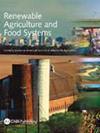灌溉有机农业生态系统秋播小粒覆盖作物的杂草抑制和土壤水分管理
IF 2
3区 农林科学
Q2 AGRICULTURE, MULTIDISCIPLINARY
引用次数: 0
摘要
摘要干旱农业生态系统中覆盖作物的采用一直很缓慢,因为人们担心水资源有限和土壤水分可能耗尽。在灌溉有机系统中,还必须考虑到对水资源保护的关注,考虑覆盖作物的潜在生态系统服务。秋季播种的小型粮食覆盖作物可以实现建设性的平衡;然而,人们对其对灌溉有机系统的影响知之甚少。我们的第一个目标是确定秋季播种的小谷物[谷类黑麦(Secale cereale L)、冬小麦(Triticum aestivum L.)、大麦(Hordeum vulgare L.)和燕麦(Avena sativa L.)]在美国西南部灌溉的有机过渡田中抑制冬季杂草的能力。前A.W.Hill)。2013年春季和2014年春季,在每种覆盖作物处理中确定了杂草密度和生物量,并与未种植的对照进行了比较。结果表明,大麦和燕麦均能有效地抑制冬季杂草。我们的第二个目标是比较美国西部开发的七个大麦品种的杂草抑制和土壤水分水平。大麦品种(“Rivat”、“Hayes Beardles”、“P919”、“Robust”、《UC603》、《UC937》、《Washford Beardles》)于2016年秋季在复制条形地块中进行了秋季播种。2017年春季测量了杂草密度,并在2016年12月至2017年3月的时间间隔测量了土壤表面附近(5.1厘米深)的体积土壤湿度。除“UC937”外,与未种植的对照相比,大麦品种的杂草密度显著降低。未播种对照的土壤水分含量始终低于大麦地块的土壤水分。大麦品种不影响土壤体积水分。在2017年至2018年的生长季节,我们重新检查了三个被认为最符合种植制度要求的大麦品种(“稳健”、“UC603”和“P919”),再次发现这些品种支持很少的杂草(≤5.0杂草m−2)。我们得出的结论是,几种有机认证的大麦品种可以满足美国西南部灌溉有机系统中抑制冬季杂草的“非干旱”覆盖作物的需求。本文章由计算机程序翻译,如有差异,请以英文原文为准。
Fall-sown small grain cover crops for weed suppression and soil moisture management in an irrigated organic agroecosystem
Abstract Adoption of cover crops in arid agroecosystems has been slow due to concerns regarding limited water resources and possible soil moisture depletion. In irrigated organic systems, potential ecosystem services from cover crops also must be considered in light of the concerns for water conservation. A constructive balance could be achieved with fall-sown small grain cover crops; however, their impacts on irrigated organic systems are poorly understood. Our first objective was to determine the ability of fall-sown small grains [cereal rye (Secale cereale L), winter wheat (Triticum aestivum L.), barley (Hordeum vulgare L.) and oat (Avena sativa L.)] to suppress winter weeds in an irrigated, organic transition field in the southwestern USA. Small grains were planted following the legume sesbania (Sesbania exaltata (Raf.) Rydb. ex A.W. Hill) during Fall 2012 and Fall 2013. In Spring 2013 and 2014, weed densities and biomass were determined within each cover crop treatment and compared against unplanted controls. Results indicated that both barley and oat were effective in suppressing winter weeds. Our second objective was to compare weed suppression and soil moisture levels among seven barley varieties developed in the western United States. Barley varieties (‘Arivat’, ‘Hayes Beardless’, ‘P919’, ‘Robust’, ‘UC603’, ‘UC937’, ‘Washford Beardless’) were fall-sown in replicated strip plots in Fall 2016. Weed densities were measured in Spring 2017 and volumetric soil moisture near the soil surface (5.1 cm depth) was measured at time intervals beginning in December 2016 and ending in March 2017. With the exception of ‘UC937’, barley varieties caused marked reductions in weed density in comparison with the unplanted control. Soil moisture content for the unplanted control was consistently lower than soil moisture contents for barley plots. Barley variety did not influence volumetric soil moisture. During the 2017–2018 growing season, we re-examined three barley varieties considered most amenable to the cropping system requirements (‘Robust’, ‘UC603’, ‘P919’), and these varieties were again found to support few weeds (≤ 5.0 weeds m−2). We conclude that several organically certified barley varieties could fill the need for a ‘non-thirsty’ cover crop that suppresses winter weeds in irrigated organic systems in the southwestern United States.
求助全文
通过发布文献求助,成功后即可免费获取论文全文。
去求助
来源期刊

Renewable Agriculture and Food Systems
农林科学-农业综合
CiteScore
5.20
自引率
7.40%
发文量
39
审稿时长
>36 weeks
期刊介绍:
Renewable Agriculture and Food Systems (formerly American Journal of Alternative Agriculture) is a multi-disciplinary journal which focuses on the science that underpins economically, environmentally, and socially sustainable approaches to agriculture and food production. The journal publishes original research and review articles on the economic, ecological, and environmental impacts of agriculture; the effective use of renewable resources and biodiversity in agro-ecosystems; and the technological and sociological implications of sustainable food systems. It also contains a discussion forum, which presents lively discussions on new and provocative topics.
 求助内容:
求助内容: 应助结果提醒方式:
应助结果提醒方式:


